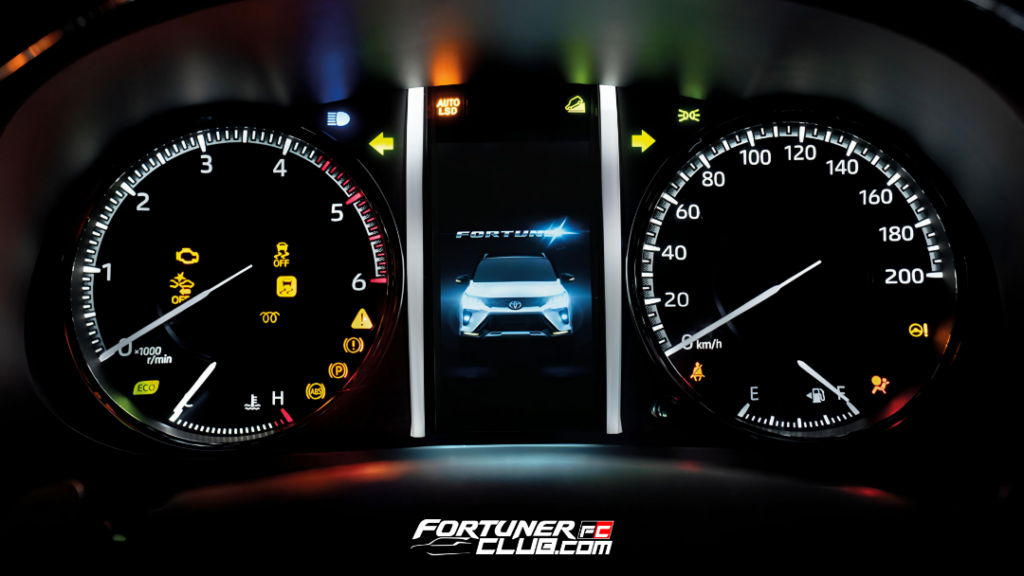Your cart is currently empty!
Toyota Fortuner Dashboard Symbols – Unlock the Secrets and Boost Your Driving Confidence

The Toyota Fortuner is known for its rugged performance and advanced technology, making it a popular choice among SUV enthusiasts. As with any modern vehicle, the Toyota Fortuner is equipped with a sophisticated dashboard that displays various symbols and warning lights. Understanding these dashboard symbols is crucial for ensuring the safety and longevity of your vehicle.
In this comprehensive guide, we’ll explore the different Toyota Fortuner dashboard symbols, what they mean, and what actions you should take when they light up.
Common Toyota Fortuner Dashboard Symbols and Their Meanings
Engine Warning Light (Check Engine) 
Description: The engine warning light, also known as the “Check Engine” light, is one of the most common dashboard symbols. When this light comes on, it indicates that there is an issue with your vehicle’s engine or emissions system.
Action: If this light remains illuminated, it’s recommended to have your vehicle inspected by a Toyota service center. Ignoring the check engine light can lead to more serious problems down the road.
Battery Warning Light 
Description: This symbol resembles a battery and indicates an issue with your vehicle’s charging system. The problem could be related to the battery, alternator, or electrical connections.
Action: If this light appears, it’s essential to have your battery and charging system checked as soon as possible to prevent a breakdown.
Oil Pressure Warning Light 
Description: The oil pressure warning light looks like an oil can and signifies low oil pressure in the engine. Low oil pressure can cause severe engine damage if not addressed promptly.
Action: Stop the vehicle immediately and check the oil level. If the oil level is normal, contact a mechanic to diagnose the problem.
ABS Warning Light 
Description: The ABS (Anti-lock Braking System) warning light indicates a malfunction in the ABS system. The ABS helps prevent the wheels from locking up during hard braking.
Action: While the vehicle can still be driven, it’s essential to have the ABS system inspected by a professional to ensure your brakes are functioning correctly.
Tire Pressure Monitoring System (TPMS) Light 
Description: The TPMS light looks like an exclamation mark inside a horseshoe and signals that one or more of your tires has low air pressure.
Action: Check the tire pressure in all tires and inflate them to the recommended levels. Driving with underinflated tires can affect your vehicle’s performance and safety.
Brake Warning Light 
Description: This symbol is usually a circle with an exclamation mark inside it, indicating an issue with your vehicle’s braking system, such as low brake fluid or a malfunctioning brake component.
Action: If this light comes on, stop driving immediately and inspect your brakes. It’s crucial to address brake issues promptly to avoid accidents.
Seat Belt Reminder 
Description: The seat belt reminder light looks like a person wearing a seatbelt. It activates when the driver or front passenger has not fastened their seatbelt.
Action: Simply buckle up to turn off this reminder. It’s a simple yet vital step for ensuring safety.
Airbag Warning Light 
Description: The airbag warning light is usually a figure with a circle in front of it, representing an airbag. When illuminated, it indicates a potential issue with the airbag system.
Action: Have your airbag system checked by a professional to ensure that it will deploy correctly in the event of an accident.
Low Fuel Warning Light 
Description: This symbol, which looks like a fuel pump, alerts you that your fuel level is low and it’s time to refuel.
Action: Refuel as soon as possible to avoid running out of fuel and getting stranded.
Coolant Temperature Warning Light 
Description: The coolant temperature warning light appears as a thermometer inside a liquid. It indicates that your engine is overheating.
Action: Pull over immediately and turn off the engine to prevent damage. Allow the engine to cool down before checking the coolant level.
Why Understanding Toyota Fortuner Dashboard Symbols Is Important
Knowing what your Toyota Fortuner dashboard symbols mean can save you time, money, and potential safety hazards. By taking prompt action when a warning light appears, you can prevent minor issues from turning into costly repairs. Additionally, staying informed about your vehicle’s condition helps you maintain optimal performance and extend its lifespan.
Conclusion: Stay Informed and Drive Safely

The Toyota Fortuner dashboard is designed to keep you informed about your vehicle’s status at all times. Familiarizing yourself with these symbols will not only enhance your driving experience but also ensure that your SUV remains in top condition. If you’re ever unsure about what a dashboard symbol means, refer to your owner’s manual or consult a certified Toyota technician.
Whether you’re a new Fortuner owner or have been driving one for years, understanding these dashboard symbols is essential for maintaining the reliability and safety of your vehicle. Stay informed and enjoy the road with confidence in your Toyota Fortuner.
Leave a Reply